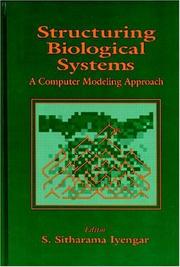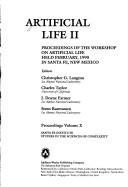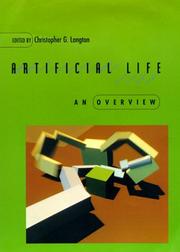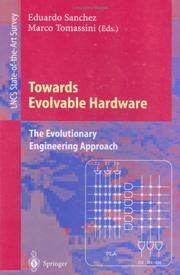| Listing 1 - 10 of 12 | << page >> |
Sort by
|

ISBN: 084937961X Year: 1992 Publisher: Boca Raton, Fla. Ann Arbor London CRC Press
Abstract | Keywords | Export | Availability | Bookmark
 Loading...
Loading...Choose an application
- Reference Manager
- EndNote
- RefWorks (Direct export to RefWorks)

ISBN: 0201525704 9780201525700 Year: 1991 Volume: 10 Publisher: Redwood City, Calif. Wokingham Amsterdam Addison-Wesley
Abstract | Keywords | Export | Availability | Bookmark
 Loading...
Loading...Choose an application
- Reference Manager
- EndNote
- RefWorks (Direct export to RefWorks)
Biological systems --- Computer simulation --- Congresses --- Simulation methods --- Biological systems - Computer simulation - Congresses. --- Biological systems - Simulation methods - Congresses. --- Biological systems - Computer simulation - Congresses --- Biological systems - Simulation methods - Congresses
Book
ISBN: 0830641505 Year: 1992 Publisher: Blue Ridge Summit, PA Windcrest
Abstract | Keywords | Export | Availability | Bookmark
 Loading...
Loading...Choose an application
- Reference Manager
- EndNote
- RefWorks (Direct export to RefWorks)
Differential geometry. Global analysis --- Neurale netwerken (Informatica) --- Réseaux neuraux (Informatique) --- Artificial intelligence --- Biological systems --- Computer simulation --- Simulation methods --- Artificial intelligence. --- Celluar automata. --- Biological systems - Computer simulation. --- Biological systems - Simulation methods. --- Neural networks (Computer science)
Book
ISBN: 1849964734 9786612973222 1282973223 1849964742 Year: 2011 Publisher: New York : Springer,
Abstract | Keywords | Export | Availability | Bookmark
 Loading...
Loading...Choose an application
- Reference Manager
- EndNote
- RefWorks (Direct export to RefWorks)
The emerging, multi-disciplinary field of systems biology is devoted to the study of the relationships between various parts of a biological system, and computer modeling plays a vital role in the drive to understand the processes of life from an holistic viewpoint. Advancements in experimental technologies in biology and medicine have generated an enormous amount of biological data on the dependencies and interactions of many different molecular cell processes, fueling the development of numerous computational methods for exploring this data. The mathematical formalism of Petri net theory is able to encompass many of these techniques. This essential text/reference presents a comprehensive overview of cutting-edge research in applications of Petri nets in systems biology, with contributions from an international selection of experts. Those unfamiliar with the field are also provided with a general introduction to systems biology, the foundations of biochemistry, and the basics of Petri net theory. Further chapters address Petri net modeling techniques for building and analyzing biological models, as well as network prediction approaches, before reviewing the applications to networks of different biological classification. Topics and features: Investigates the modular, qualitative modeling of regulatory networks using Petri nets, and examines an Hybrid Functional Petri net simulation case study Contains a glossary of the concepts and notation used in the book, in addition to exercises at the end of each chapter Covers the topological analysis of metabolic and regulatory networks, the analysis of models of signaling networks, and the prediction of network structure Provides a biological case study on the conversion of logical networks into Petri nets Discusses discrete modeling, stochastic modeling, fuzzy modeling, dynamic pathway modeling, genetic regulatory network modeling, and quantitative analysis techniques Includes a Foreword by Professor Jens Reich, Professor of Bioinformatics at Humboldt University and Max Delbrück Center for Molecular Medicine in Berlin This unique guide to the modeling of biochemical systems using Petri net concepts will be of real utility to researchers and students of computational biology, systems biology, bioinformatics, computer science, and biochemistry. Dr. Ina Koch is a Professor and holds the Chair of Bioinformatics at the Johann Wolfgang Goethe-University Frankfurt am Main, Germany. Dr. Wolfgang Reisig is a Professor and holds the Chair in the Theory of Programming at the Humboldt University of Berlin, Germany. Dr. Falk Schreiber is a Professor and holds the Chair of Bioinformatics at the Martin Luther University Halle-Wittenberg, Germany, and the Coordinator of Bioinformatics at the Leibniz Institute of Plant Genetics and Crop Plant Research Gatersleben, Germany.
Bioinformatics. --- Biological systems -- Computer simulation. --- Biological systems -- Mathematical models. --- Computational biology. --- Systems biology. --- Systems biology --- Petri nets --- Biology --- Health & Biological Sciences --- Biology - General --- Petri nets. --- Computer science. --- Computer Science. --- Computational Biology/Bioinformatics. --- Systems Biology. --- Computational biology --- Bioinformatics --- Biological systems --- Molecular biology --- Bio-informatics --- Biological informatics --- Information science --- Informatics --- Science --- Data processing --- Graph theory --- Nets (Mathematics) --- Biological models. --- Models, Biological

ISBN: 3540594965 3540492860 9783540594963 Year: 1995 Volume: 929 Publisher: Berlin : Springer-Verlag,
Abstract | Keywords | Export | Availability | Bookmark
 Loading...
Loading...Choose an application
- Reference Manager
- EndNote
- RefWorks (Direct export to RefWorks)
This volume contains 71 revised refereed papers, including seven invited surveys, presented during the Third European Conference on Artificial Life, ECAL '95, held in Granada, Spain in June 1995. Originally AL was concerned with applying biologically inspired solutions to technology and with examining computational expertise in order to reproduce and understand life processes. Despite its short history, AL now is becoming a mature scientific field. The volume reports the state of the art in this exciting area of research; there are sections on foundations and epistemology, origins of life and evolution, adaptive and cognitive systems, artificial worlds, robotics and emulation of animal behavior, societies and collective behavior, biocomputing, and applications and common tools.
Biological systems --- Artificial intelligence --- Robotics --- Computer simulation --- Congresses. --- Simulation methods --- Congresses --- Artificial intelligence. --- Anthropology. --- Life sciences. --- Biology --- Statistics. --- Artificial Intelligence. --- Life Sciences, general. --- Computer Appl. in Life Sciences. --- Mathematical and Computational Biology. --- Statistics for Life Sciences, Medicine, Health Sciences. --- Data processing. --- Human beings --- AI (Artificial intelligence) --- Artificial thinking --- Electronic brains --- Intellectronics --- Intelligence, Artificial --- Intelligent machines --- Machine intelligence --- Thinking, Artificial --- Bionics --- Cognitive science --- Digital computer simulation --- Electronic data processing --- Logic machines --- Machine theory --- Self-organizing systems --- Fifth generation computers --- Neural computers --- Statistical analysis --- Statistical data --- Statistical methods --- Statistical science --- Mathematics --- Econometrics --- Biosciences --- Sciences, Life --- Science --- Biological systems - Computer simulation - Congresses. --- Biological systems - Simulation methods - Congresses. --- Artificial intelligence - Congresses. --- Robotics - Congresses.
Book
ISBN: 9400790228 9400701489 9786613084491 9400701497 128308449X Year: 2011 Publisher: Dordrecht : Springer,
Abstract | Keywords | Export | Availability | Bookmark
 Loading...
Loading...Choose an application
- Reference Manager
- EndNote
- RefWorks (Direct export to RefWorks)
Simulation and Verification of Electronic and Biological Systems provides a showcase for the Circuit and Multi-Domain Simulation Workshop held in San Jose, California, USA, on November 5, 2009. The nine chapters are contributed by experts in the field and provide a broad discussion of recent developments on simulation, modeling and verification of integrated circuits and biological systems. Specific topics include large scale parallel circuit simulation, industrial practice of fast SPICE simulation, structure-preserving model order reduction of interconnects, advanced simulation techniques for oscillator networks, dynamic stability of static memories and biological systems as well as verification of analog integrated circuits. Simulation and verification are fundamental enablers for understanding, analyzing and designing an extremely broad range of engineering and biological circuits and systems. The design of nanometer integrated electronic systems and emerging biomedical applications have stimulated the development of novel simulation and verification techniques and methodologies. Simulation and Verification of Electronic and Biological Systems provides a broad discussion of recent advances on simulation, modeling and verification of integrated circuits and biological systems and offers a basis for stimulating new innovations.
Biological systems -- Computer simulation -- Congresses. --- Integrated circuits -- Computer simulation -- Congresses. --- Integrated circuits -- Verification -- Congresses. --- Nanoelectronics -- Congresses. --- Electrical & Computer Engineering --- Engineering & Applied Sciences --- Electrical Engineering --- Biological systems --- Computer simulation. --- Simulation methods. --- Mathematical models. --- Biosystems --- Systems, Biological --- Engineering. --- Nanotechnology. --- Electronic circuits. --- Circuits and Systems. --- Simulation and Modeling. --- Nanotechnology and Microengineering. --- Biology --- System theory --- Systems biology --- Philosophy --- Systems engineering. --- Construction --- Industrial arts --- Technology --- Computer modeling --- Computer models --- Modeling, Computer --- Models, Computer --- Simulation, Computer --- Electromechanical analogies --- Mathematical models --- Simulation methods --- Model-integrated computing --- Engineering systems --- System engineering --- Engineering --- Industrial engineering --- System analysis --- Design and construction --- Molecular technology --- Nanoscale technology --- High technology --- Electron-tube circuits --- Electric circuits --- Electron tubes --- Electronics
Book
ISBN: 9400768028 9400794541 9400768036 Year: 2013 Publisher: Dordrecht : Springer,
Abstract | Keywords | Export | Availability | Bookmark
 Loading...
Loading...Choose an application
- Reference Manager
- EndNote
- RefWorks (Direct export to RefWorks)
Growth in the pharmaceutical market has slowed down – almost to a standstill. One reason is that governments and other payers are cutting costs in a faltering world economy. But a more fundamental problem is the failure of major companies to discover, develop and market new drugs. Major drugs losing patent protection or being withdrawn from the market are simply not being replaced by new therapies – the pharmaceutical market model is no longer functioning effectively and most pharmaceutical companies are failing to produce the innovation needed for success. This multi-authored new book looks at a vital strategy which can bring innovation to a market in need of new ideas and new products: Systems Biology (SB). Modeling is a significant task of systems biology. SB aims to develop and use efficient algorithms, data structures, visualization and communication tools to orchestrate the integration of large quantities of biological data with the goal of computer modeling. It involves the use of computer simulations of biological systems, such as the networks of metabolites comprise signal transduction pathways and gene regulatory networks to both analyze and visualize the complex connections of these cellular processes. SB involves a series of operational protocols used for performing research, namely a cycle composed of theoretical, analytic or computational modeling to propose specific testable hypotheses about a biological system, experimental validation, and then using the newly acquired quantitative description of cells or cell processes to refine the computational model or theory.
Biological systems -- Computer simulation. --- Biological systems. --- Systems biology. --- Computational biology. --- Medicine. --- Computer simulation. --- Microbial genetics. --- Microbial genomics. --- Biomedical engineering. --- Biomedicine. --- Biomedicine general. --- Microbial Genetics and Genomics. --- Simulation and Modeling. --- Biomedical Engineering. --- Biology --- Bioinformatics --- Computational biology --- Biological systems --- Molecular biology --- Biomedical Engineering and Bioengineering. --- Genomics --- Microbial genetics --- Microorganisms --- Genetics --- Microbiology --- Clinical sciences --- Medical profession --- Human biology --- Life sciences --- Medical sciences --- Pathology --- Physicians --- Clinical engineering --- Medical engineering --- Bioengineering --- Biophysics --- Engineering --- Medicine --- Computer modeling --- Computer models --- Modeling, Computer --- Models, Computer --- Simulation, Computer --- Electromechanical analogies --- Mathematical models --- Simulation methods --- Model-integrated computing --- Health Workforce --- Biomedicine, general.
Book
ISBN: 1461421454 1489987509 1461421462 1280853948 9786613711793 Year: 2012 Publisher: New York : Springer,
Abstract | Keywords | Export | Availability | Bookmark
 Loading...
Loading...Choose an application
- Reference Manager
- EndNote
- RefWorks (Direct export to RefWorks)
Computational modeling is emerging as a powerful new approach for studying and manipulating biological systems. Many diverse methods have been developed to model, visualize, and rationally alter these systems at various length scales, from atomic resolution to the level of cellular pathways. Processes taking place at larger time and length scales, such as molecular evolution, have also greatly benefited from new breeds of computational approaches. Computational Modeling of Biological Systems: From Molecules to Pathways provides an overview of established computational methods for the modeling of biologically and medically relevant systems. It is suitable for researchers and professionals working in the fields of biophysics, computational biology, systems biology, and molecular medicine.
Biological systems -- Computer simulation. --- Systems biology. --- Biology --- Health & Biological Sciences --- Biology - General --- Biophysics --- Biomedical engineering. --- Molecular dynamics. --- Dynamics, Molecular --- Clinical engineering --- Medical engineering --- Physics. --- Molecular biology. --- Bioinformatics. --- Biomathematics. --- Biophysics. --- Biological physics. --- Biophysics and Biological Physics. --- Molecular Medicine. --- Mathematical and Computational Biology. --- Computational Biology/Bioinformatics. --- Biological physics --- Medical sciences --- Physics --- Mathematics --- Bio-informatics --- Biological informatics --- Information science --- Computational biology --- Systems biology --- Molecular biochemistry --- Molecular biophysics --- Biochemistry --- Biomolecules --- Natural philosophy --- Philosophy, Natural --- Physical sciences --- Dynamics --- Data processing --- Bioengineering --- Engineering --- Medicine --- Medicine. --- Biological and Medical Physics, Biophysics. --- Clinical sciences --- Medical profession --- Human biology --- Life sciences --- Pathology --- Physicians --- Health Workforce

ISBN: 0262621126 0262277921 0262121891 0585036152 9780262121897 9780262277921 9780585036151 9780262621120 Year: 1995 Publisher: Cambridge, Massachusetts [Piscataqay, New Jersey] MIT Press IEEE Xplore
Abstract | Keywords | Export | Availability | Bookmark
 Loading...
Loading...Choose an application
- Reference Manager
- EndNote
- RefWorks (Direct export to RefWorks)
Artificial life, a field that seeks to increase the role of synthesis in the study of biological phenomena, has great potential, both for unlocking the secrets of life and for raising a host of disturbing issues -- scientific and technical as well as philosophical and ethical. This book brings together a series of overview articles that appeared in the first three issues of the groundbreaking journal Artificial Life, along with a new introduction by Christopher Langton, Editor-in-Chief of Artificial Life, founder of the discipline, and Director of the Artificial Life Program at the Santa Fe Institute.
Biomathematics. Biometry. Biostatistics --- General biophysics --- Artificial intelligence. Robotics. Simulation. Graphics --- Artificial intelligence --- Biological systems --- Biosystems --- Systems, Biological --- Biology --- System theory --- Systems biology --- AI (Artificial intelligence) --- Artificial thinking --- Electronic brains --- Intellectronics --- Intelligence, Artificial --- Intelligent machines --- Machine intelligence --- Thinking, Artificial --- Bionics --- Cognitive science --- Digital computer simulation --- Electronic data processing --- Logic machines --- Machine theory --- Self-organizing systems --- Simulation methods --- Fifth generation computers --- Neural computers --- Computer simulation --- Philosophy --- Artificial intelligence. --- Computer simulation. --- Simulation methods. --- Systèmes biologiques --- Intelligence artificielle --- Simulation par ordinateur --- Biological systems - Computer simulation --- Biological systems - Simulation methods --- Use of --- Computers --- COMPUTER SCIENCE/Artificial Intelligence

ISBN: 3540610936 3540499474 9783540610939 Year: 1996 Volume: 1062 Publisher: Berlin [etc.] : Springer-Verlag,
Abstract | Keywords | Export | Availability | Bookmark
 Loading...
Loading...Choose an application
- Reference Manager
- EndNote
- RefWorks (Direct export to RefWorks)
Evolutionary computing, inspired by the biological world, is one of the emergent technologies of our time. Being essentially a software activity, it has been successfully applied, e.g. for optimization and machine learning in various areas. The tremendous increase in computational power and, more recently, the appearance of a new generation of programmable logic devices allow for a new approach to designing computing machines inspired by biological models: it is now possible to make the hardware itself evolve. This book is based on a workshop on evolvable hardware, held in Lausanne, Switzerland, in October 1995. It reports the state of the art of research in this field and presents two introductory chapters, written with the novice reader in mind.
Algorithmes génétiques --- Dispositifs logiques programmables --- Evolutionaire programmering (Informatica) --- Evolutionary programming (Computer science) --- Genetic algorithms --- Genetische algoritmen --- Programmable logic devices --- Programmation évolutive (Informatique) --- Programmeerbare logische bouwsteen --- Computers --- Genetic Algorithms --- Biological systems --- Circuits --- Computer simulation --- Information theory. --- Computer hardware. --- Logic design. --- Computer science. --- Computer simulation. --- Artificial intelligence. --- Theory of Computation. --- Computer Hardware. --- Logic Design. --- Register-Transfer-Level Implementation. --- Simulation and Modeling. --- Artificial Intelligence. --- AI (Artificial intelligence) --- Artificial thinking --- Electronic brains --- Intellectronics --- Intelligence, Artificial --- Intelligent machines --- Machine intelligence --- Thinking, Artificial --- Bionics --- Cognitive science --- Digital computer simulation --- Electronic data processing --- Logic machines --- Machine theory --- Self-organizing systems --- Simulation methods --- Fifth generation computers --- Neural computers --- Computer modeling --- Computer models --- Modeling, Computer --- Models, Computer --- Simulation, Computer --- Electromechanical analogies --- Mathematical models --- Model-integrated computing --- Informatics --- Science --- Design, Logic --- Design of logic systems --- Digital electronics --- Electronic circuit design --- Logic circuits --- Switching theory --- Communication theory --- Communication --- Cybernetics --- Computers - Circuits --- Biological systems - Computer simulation
| Listing 1 - 10 of 12 | << page >> |
Sort by
|

 Search
Search Feedback
Feedback About UniCat
About UniCat  Help
Help News
News